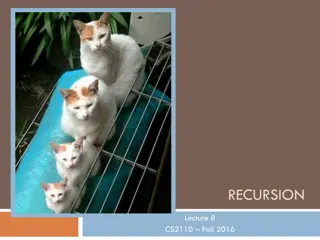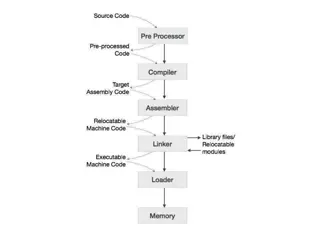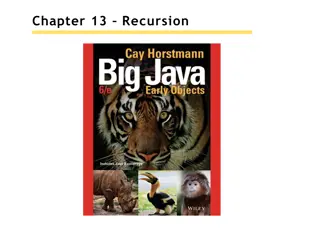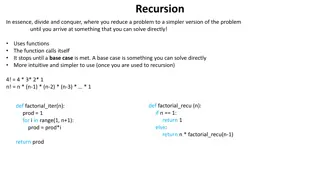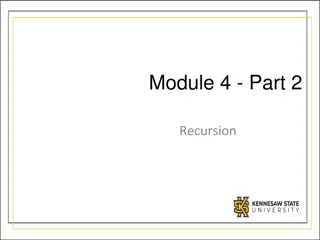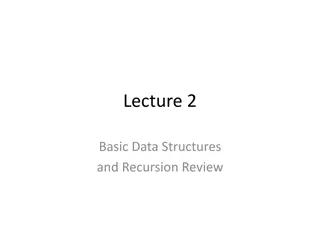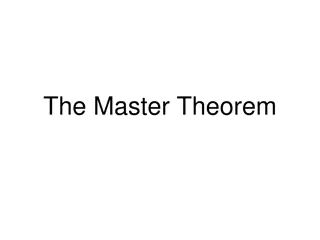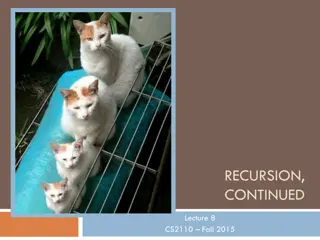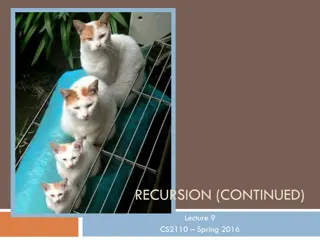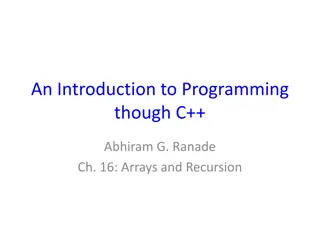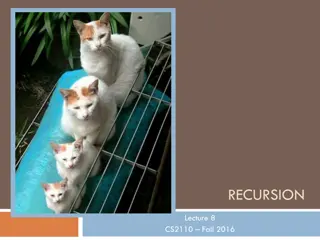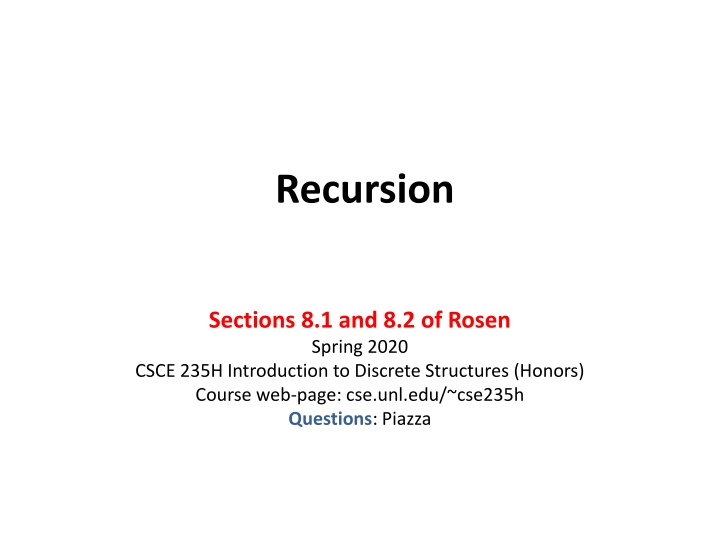
Recursion in Discrete Structures: CSCE 235 Overview
In this material from the CSCE 235H course on Discrete Structures, the concept of recursion is explored in detail. Discussions cover the introduction of recurrence relations to express the cost of recursive algorithms and how to solve them. Various topics such as linear and nonhomogeneous recurrences, recursive algorithms analysis, and motivating examples like factorial calculations are included. The advantages, disadvantages, and use cases of recursion, along with the analysis of recursive algorithms, are also discussed.
Download Presentation

Please find below an Image/Link to download the presentation.
The content on the website is provided AS IS for your information and personal use only. It may not be sold, licensed, or shared on other websites without obtaining consent from the author. If you encounter any issues during the download, it is possible that the publisher has removed the file from their server.
You are allowed to download the files provided on this website for personal or commercial use, subject to the condition that they are used lawfully. All files are the property of their respective owners.
The content on the website is provided AS IS for your information and personal use only. It may not be sold, licensed, or shared on other websites without obtaining consent from the author.
E N D
Presentation Transcript
Recursion Sections 8.1 and 8.2 of Rosen Spring 2020 CSCE 235H Introduction to Discrete Structures (Honors) Course web-page: cse.unl.edu/~cse235h Questions: Piazza
Recursion Introduce recurrence relation to express the cost of a recursive algorithm Show that the solution of a recurrence relation is a sequence 2 CSCE 235 Recursion
Outline Introduction, Motivating Example Recurrence Relations Definition, general form, initial conditions, terms Linear Homogeneous Recurrences Form, solution, characteristic equation, characteristic polynomial, roots Second order linear homogeneous recurrence Double roots, solution, examples Single root, example General linear homogeneous recurrences: distinct roots, any multiplicity Linear Nonhomogenous Recurrences Other Methods Backward substitution Recurrence trees Cheating with Maple 3 CSCE 235 Recursion
Recursive Algorithms A recursive function is one in which objects are defined in terms of other objects of the same type Advantages Simplicity of code, easy to understand Disadvantages Memory, speed, possibly redundant work Tail recursion offers a solution to the memory problem, but really, do we need recursion? 4 CSCE 235 Recursion
Recursive Algorithms: Analysis We have already discussed how to analyze the running time of (iterative) algorithms To analyze recursive algorithms, we require more sophisticated techniques Specifically, we study how to define & solve recurrence relations 5 CSCE 235 Recursion
Motivating Examples: Factorial Recall the factorial function: Consider the following (recursive) algorithm for computing n! Factorial Input: n N Output: n! 1. If (n=1) or (n=0) 2. Then Return 1 3. Else Return n Factorial(n-1) 4. Endif 5. End 6 CSCE 235 Recursion
Factorial: Analysis How many multiplications M(x) does factorial perform? When n=1 we don t perform any Otherwise, we perform one plus how ever many multiplications we perform in the recursive call Factorial(n-1) The number of multiplications can be expressed as a formula similar to the definition of n! M(1) = 0 M(n) = 1 + M(n-1) This relation is a recurrence relation 7 CSCE 235 Recursion
Recurrence Relations Example Consider the recurrence relation: an= 2an-1-an-2 Verify that the sequence {an} with an = 3n is a solution Definition: A recurrence relation for a sequence {an} is an equation that expresses an in terms of one or more of the previous terms in the sequence: a0, a1, a2, , an-1 for all integers n n0 where n0 is a nonnegative integer. A sequence is called a solution of a recurrence if its terms satisfy the recurrence relation 8 CSCE 235 Recursion
Recurrence Relations: Solutions Consider the recurrence relation an=2an-1-an-2 It has the following sequences an as solutions an= 3n an= n+1 an=5 The initial conditions + recurrence relation uniquely determine the sequence 9 CSCE 235 Recursion
Recurrence Relations: Example The Fibonacci numbers are defined by the recurrence F(n) = F(n-1) +F(n-2) F(1) = 1 F(0) = 1 The solution to the Fibonacci recurrence is (The solution is derived in your textbook.) 10 CSCE 235 Recursion
Outline Introduction, Motivating Example Recurrence Relations Definition, general form, initial conditions, terms Linear Homogeneous Recurrences Form, solution, characteristic equation, characteristic polynomial, roots Second order linear homogeneous recurrence Double roots, solution, examples Single root, example General linear homogeneous recurrences: distinct roots, any multiplicity Linear Nonhomogenous Recurrences Other Methods Backward substitution Recurrence trees Cheating with Maple 11 CSCE 235 Recursion
Recurrence Relations: General Form Call on n More generally, recurrences can have the form T(n) = T(n- ) + f(n), T( ) = c or T(n) = T(n/ ) + f(n), T( ) = c . .. Call on n- Call on n- Note that it may be necessary to define several T( ), which are the initial conditions 12 CSCE 235 Recursion
Recurrence Relations: Initial Conditions The initial conditions specify the values of the first few terms in the recurrence, which are necessary to uniquely determine the solution In the Fibonacci numbers, we needed two initial conditions: F(0)=F(1)=1 because F(n) is defined by the two previous terms in the sequence Initial conditions are also known as boundary conditions From now on, we will use the subscript notation, so the Fibonacci numbers are: fn = fn-1 + fn-2 f1 = 1 f0 = 1 13 CSCE 235 Recursion
Recurrence Relations: Terms Call on n Recurrence relations have two parts: recursive terms and non-recursive terms T(n) = 2T(n-2) + n2 -10 Recursive terms come from when an algorithms calls itself Non-recursive terms correspond to the non-recursive cost of the algorithm: work the algorithm performs within a function We will see examples later. First, we need to know how to solve recurrences. . .. Call on n-2 Call on n-2 14 CSCE 235 Recursion
Solving Recurrences There are several methods for solving recurrences Characteristic Equations Backward Substitution Recurrence Trees Maple! 15 CSCE 235 Recursion
Outline Introduction, Motivating Example Recurrence Relations Definition, general form, initial conditions, terms Linear Homogeneous Recurrences Form, solution, characteristic equation, characteristic polynomial, roots Second order linear homogeneous recurrence Double roots, solution, examples Single root, example General linear homogeneous recurrences: distinct roots, any multiplicity Linear Nonhomogenous Recurrences Other Methods Backward substitution Recurrence trees Cheating with Maple 16 CSCE 235 Recursion
Linear Homogeneous Recurrences Definition: A linear homogeneous recurrence relation of degree k with constant coefficients is a recurrence relation of the form an = c1an-1 + c2an-2 + + ckan-k with c1, c2, , ck R, ck 0. Example: an = 2an-1 - an-2 , c1=2, c2=-1 Linear: RHS is a sum of multiples of previous terms of the sequence (linear combination of previous terms). The coefficients are all constants (not functions depending on n) Homogeneous: no terms occur that are not multiples of aj s Degree k: an is expressed in terms of (n-k)th term of the sequence 17 CSCE 235 Recursion
Linear Homogeneous Recurrences: Examples The Fibonacci function is a linear homogeneous recurrence relation So are the following recurrence relations an = 4an-1 + 5an-2 + 7an-3 an = 2an-2 + 4an-4 + 8an-8 How many initial conditions do we need to specify for these relations? As many as the degree k: k = 3, 8 respectively So, how do solve linear homogeneous recurrences? 18 CSCE 235 Recursion
Solving Linear Homogeneous Recurrences We want a solution of the form an=rn where r is some real constant We observe that an=rn is a solution to a linear homogeneous recurrence if and only if rn = c1rn-1 + c2rn-2 + + ckrn-k We can now divide both sides by rn-k, collect terms and we get a k-degree polynomial rk - c1rk-1 - c2rk-2 - - ck = 0 This equation is called the characteristic equation of the recurrence relation The roots of this polynomial are called the characteristics roots of the recurrence relation. They can be used to find the solutions (if they exist) to the recurrence relation. We will consider several cases. 19 CSCE 235 Recursion
Second Order Linear Homogeneous Recurrences A second order (k=2) linear homogeneous recurrence is a recurrence of the form an = c1an-1+ c2an-2 Theorem (Theorem 1, page 462): Let c1, c2 R and suppose that r2-c1r-c2=0 is the characteristic polynomial of a 2nd order linear homogeneous recurrence that has two distinct* roots r1,r2, then {an} is a solution if and only if an= 1r1n + 2r2n for n=0,1,2, where 1, 2 are constants dependent upon the initial conditions * We discuss single root later 20 CSCE 235 Recursion
Second Order Linear Homogeneous Recurrences: Example A (1) Find a solution to an = 5an-1 - 6an-2 with initial conditions a0=1, a1=4 The characteristic equation is r2 - 5r + 6 = 0 The roots are r1=2, r2=3 r2 - 5r + 6 = (r-2)(r-3) Using the 2nd order theorem we have a solution an = 12n + 23n CSCE 235 21 Recursion
Second Order Linear Homogeneous Recurrences: Example A (2) Given the solution an = 12n + 23n We plug in the two initial conditions to get a system of linear equations a0=1, a1=4 a0 = 120 + 230 a1 = 121 + 231 Thus: 1 = 1+ 2 4 = 2 1 + 3 2 22 CSCE 235 Recursion
Second Order Linear Homogeneous Recurrences: Example A (3) 1 = 1 + 2 4 = 2 1 + 3 2 Solving for 1 = (1 - 2), we get 4 = 2 1 + 3 2 4 = 2(1- 2) + 3 2 4 = 2 - 2 2 + 3 2 2 = 2 Substituting for 1: 1 = -1 Putting it back together, we have an = 12n + 23n an = -1 2n + 2 3n 23 CSCE 235 Recursion
Second Order Linear Homogeneous Recurrences: Example B (1) Solve the recurrence an = -2an-1 + 15an-2 with initial conditions a0= 0, a1= 1 If we did it right, we have an = 1/8 (3)n - 1/8 (-5)n To check ourselves, we verify a0, a1, we compute a3 with both equations, then maybe a4, etc. 24 CSCE 235 Recursion
Single Root Case We can apply the theorem if the roots are distincts, i.e. r1 r2 If the roots are not distinct (r1=r2), we say that one characteristic root has multiplicity two. In this case, we apply a different theorem Theorem (Theorem2, page 464) Let c1, c2 R and suppose that r2 - c1r - c2 = 0 has only one distinct root, r0, then {an} is a solution to an = c1an-1+ c2an-2 if and only if an= 1r0n + 2nr0n for n=0,1,2, where 1, 2 are constants depending upon the initial conditions 25 CSCE 235 Recursion
Single Root Case: Example (1) What is the solution to the recurrence relation an = 8an-1 - 16an-2 with initial conditions a0= 1, a1= 7? The characteristic equation is: r2 8r + 16 = 0 Factoring gives us: r2 8r + 16 = (r-4)(r-4), so r0=4 Applying the theorem we have the solution: an= 1(4)n + 2n(4)n 26 CSCE 235 Recursion
Single Root Case: Example (2) Given: an= 1(4)n + 2n(4)n Using the initial conditions, we get: a0= 1 = 1(4)0 + 20(4)0 = 1 a1= 7 = 1(4)+ 21(4)1 = 4 1 + 4 2 Thus: = 1 = 1, 2 = 3/4 The solution is an= (4)n + n (4)n Always check yourself 27 CSCE 235 Recursion
General Linear Homogeneous Recurrences There is a straightforward generalization of these cases to higher-order linear homogeneous recurrences Essentially, we simply define higher degree polynomials The roots of these polynomials lead to a general solution The general solution contains coefficients that depend only on the initial conditions In the general case, the coefficients form a system of linear equalities 28 CSCE 235 Recursion
General Linear Homogeneous Recurrences: Distinct Roots Theorem (Theorem 3, page 465) Let c1,c2,..,ck R and suppose that the characteristic equation rk - c1rk-1 - c2rk-2 - - ck = 0 has k distinct roots r1,r2, ,rk. Then a sequence {an} is a solution of the recurrence relation an = c1an-1 + c2an-2 + + ckan-k if and only if an = 1r1n + 2r2n + + krkn for n=0,1,2, where 1, 2, , k are constants depending upon the initial conditions CSCE 235 29 Recursion
General Linear Homogeneous Recurrences: Any Multiplicity Theorem (Theorem 3, page 465) Let c1,c2,..,ck R and suppose that the characteristic equation rk - c1rk-1 - c2rk-2 - - ck = 0 has t roots with multiplicities m1,m2, ,mt. Then a sequence {an} is a solution of the recurrence relation an = c1an-1 + c2an-2 + + ckan-k if and only if an = ( 1,0 + 1,1n + + 1,m1-1nm1-1)r1n + ( 2,0 + 2,1n + + 2,m2-1nm2-1)r2n + ... ( t,0 + t,1n + + t,mt-1nmt-1)rtn for n=0,1,2, where i,j are constants for 1 i t and 0 j mi-1 depending upon the initial conditions 30 CSCE 235 Recursion
Outline Introduction, Motivating Example Recurrence Relations Definition, general form, initial conditions, terms Linear Homogeneous Recurrences Form, solution, characteristic equation, characteristic polynomial, roots Second order linear homogeneous recurrence Double roots, solution, examples Single root, example General linear homogeneous recurrences: distinct roots, any multiplicity Linear Nonhomogenous Recurrences Other Methods Backward substitution Recurrence trees Cheating with Maple 31 CSCE 235 Recursion
Linear NonHomogeneous Recurrences For recursive algorithms, cost function are often not homogeneous because there is usually a non-recursive cost depending on the input size Such a recurrence relation is called a linear nonhomogeneous recurrence relation Such functions are of the form an = c1an-1 + c2an-2 + + ckan-k+ f(n) f(n) represents a non-recursive cost. If we chop it off, we are left with an = c1an-1 + c2an-2 + + ckan-k which is the associated homogeneous recurrence relation Every solution of a linear nonhomogeneous recurrence relation is the sum of a particular solution and a solution to the associated linear homogeneous recurrence relation 32 CSCE 235 Recursion
Solving Linear NonHomogeneous Recurrences (1) Theorem (Theorem 5, p468) If {an(p)} is a particular solution of the nonhomogeneous linear recurrence relation with constant coefficients an = c1an-1 + c2an-2 + + ckan-k+ f(n) then every solution is of the form {an(p) + an(h)} where {an(h)} is a solution of the associated homogeneous recurrence relation an = c1an-1 + c2an-2 + + ckan-k 33 CSCE 235 Recursion
Solving Linear NonHomogeneous Recurrences (2) There is no general method for solving such relations. However, we can solve them for special cases In particular, if f(n) is a polynomial function exponential function, or the product of a polynomial and exponential functions, then there is a general solution 34 CSCE 235 Recursion
Solving Linear NonHomogeneous Recurrences (3) Theorem (Theorem 6, p469) Suppose {an} satisfies the linear nonhomogeneous recurrence relation an = c1an-1 + c2an-2 + + ckan-k+ f(n) where c1,c2,..,ck R and f(n) = (btnt + bt-1nt-1 + .. + b1n + b0) sn where b0,b1,..,bn,s R continues 35 CSCE 235 Recursion
Solving Linear NonHomogeneous Recurrences (4) Theorem(Theorem 6, p469) continued When s is not a root of the characteristic equation of the associated linear homogeneous recurrence relation, there is a particular solution of the form (ptnt+ pt-1nt-1+ +p1n + p0) sn When s is a root of this characteristic equation and its multiplicity is m, there is a particular solution of the form nm(ptnt+ pt-1nt-1+ +p1n + p0) sn 36 CSCE 235 Recursion
Linear NonHomogeneous Recurrences: Examples The examples in the textbook are quite good (see pp467 470) and illustrate how to solve simple nonhomogeneous relations We may go over more examples if time allows Also read up on generating functions in Section 7.4 (though we may return to this subject) However, there are alternate, more intuitive methods 37 CSCE 235 Recursion
Recursion: Review The cost of a recursive algorithm is modeled as a recurrence relation The solution of a recurrence relation is a sequence A recurrence relation is defined using previous terms of the sequence The recurrence relation has Recursive terms Non-recursive terms Initial conditions, which uniquely determine the sequence Linear homogeneous recurrence relation of degree ? Charateristic equation, a polynomial of degree ? Requires ? initial conditions Solving second order linear homogeneous recurrence relation by finding the roots of the characteristic polynomial an= 1r1n + 2r2n an= 1r0n + 2nr0n 38 CSCE 235 Recursion
Outline Introduction, Motivating Example Recurrence Relations Definition, general form, initial conditions, terms Linear Homogeneous Recurrences Form, solution, characteristic equation, characteristic polynomial, roots Second order linear homogeneous recurrence Double roots, solution, examples Single root, example General linear homogeneous recurrences: distinct roots, any multiplicity Linear Nonhomogenous Recurrences Other Methods Backward substitution Recurrence trees Cheating with Maple 39 CSCE 235 Recursion
Other Methods When analyzing algorithms, linear homogeneous recurrences of order greater than 2 hardly ever arise in practice We briefly describe two unfolding methods that work for a lot of cases Backward substitution: this works exactly as its name suggests. Starting from the equation itself, work backwards, substituting values of the function for previous ones Recurrence trees: just as powerful, but perhaps more intuitive, this method involves mapping out the recurrence tree for an equation. Starting from the equation, you unfold each recursive call to the function and calculate the non-recursive cost at each level of the tree. Then, you find a general formula for each level and take a summation over all such levels 40 CSCE 235 Recursion
Backward Substitution: Example (1) Give a solution to T(n)= T(n-1) + 2n where T(1)=5 We begin by unfolding the recursion by a simple substitution of the function values We observe that T(n-1) = T((n-1) - 1) + 2(n-1) = T(n-2) + 2(n-1) Substituting into the original equation T(n)=T(n-2)+2(n-1)+2n 41 CSCE 235 Recursion
Backward Substitution: Example (2) If we continue to do that we get T(n) = T(n-2) + 2(n-1) + 2n T(n) = T(n-3) + 2(n-2) + 2(n-1) + 2n T(n) = T(n-4) + 2(n-3) + 2(n-2) + 2(n-1) + 2n .. T(n) = T(n-i) + j=0i-1 2(n - j) function s value at the ith iteration Solving the sum we get T(n) = T(n-i) + 2n(i-1) 2(i-1)(i-1+1)/2 + 2n T(n) = T(n-i) + 2n(i-1) i2 + i + 2n 42 CSCE 235 Recursion
Backward Substitution: Example (3) We want to get rid of the recursive term T(n) = T(n-i) + 2n(i-1) i2 + i + 2n To do that, we need to know at what iteration we reach our based case, i.e. for what value of i can we use the initial condition T(1)=5? We get the base case when n-i=1 or i=n-1 Substituting in the equation above we get T(n) = 5 + 2n(n-1-1) (n-1)2 + (n-1) + 2n T(n) = 5 + 2n(n-2) (n2-2n+1) + (n-1) + 2n = n2 + n + 3 43 CSCE 235 Recursion
Backward Substitution Starting from the equation itself, work backwards, substituting values of the function for previous ones T(n) = T(n- ) + f(n), T( ) = c T(n) = T(n/ ) + f(n), T( ) = c 44 CSCE 235 Recursion
Recurrence Trees (1) When using recurrence trees, we graphically represent the recursion Each node in the tree is an instance of the function. As we progress downward, the size of the input decreases The contribution of each level to the function is equivalent to the number of nodes at that level times the non-recursive cost on the size of the input at that level The tree ends at the depth at which we reach the base case As an example, we consider a recursive function of the form T(n) = T(n/ ) + f(n), T( ) = c 45 CSCE 235 Recursion
Recurrence Trees (2) Iteration 0 Cost f(n) TT(n) 1 f(n/ ) T(n/ ) T(n/ ) T(n/ ) 2 . . i . . T(n/ 2) T(n/ 2) T(n/ 2) T(n/ 2) 2f(n/ 2) . . i f(n/ i) . . log n 46 CSCE 235 Recursion
Recurrence Trees (3) The total value of the function is the summation over all levels of the tree Consider the following concrete example T(n) = 2T(n/2) + n, T(1)= 4 47 CSCE 235 Recursion
Recurrence Tree: Example (2) Iteration 0 Cost n T(n) T(n/2) T(n/2) 1 n/2 +n/2 T(n/4) T(n/4) T(n/4) T(n/4) 4. n/4 2 . . i . . 8.n/8 . . 2i(n/2i) . . T(n/8) T(n/8) T(n/8) T(n/8) T(n/8) T(n/8) T(n/8) T(n/8) log2 n 48 CSCE 235 Recursion
Recurrence Trees: Example (3) The value of the function is the summation of the value of all levels. We treat the last level as a special case since its non-recursive cost is different 49 CSCE 235 Recursion
Smoothness Rule In the previous example, we make the following assumption n has a power of two (n=2k) This assumption is necessary to get a nice depth of log(n) and a full tree We can restrict consideration to certain powers because of the smoothness rule, which is not studied in this course. For more information about that rule, consult pages 481 483 of the textbook The Design & Analysis of Algorithms by Anany Levitin 50 CSCE 235 Recursion



